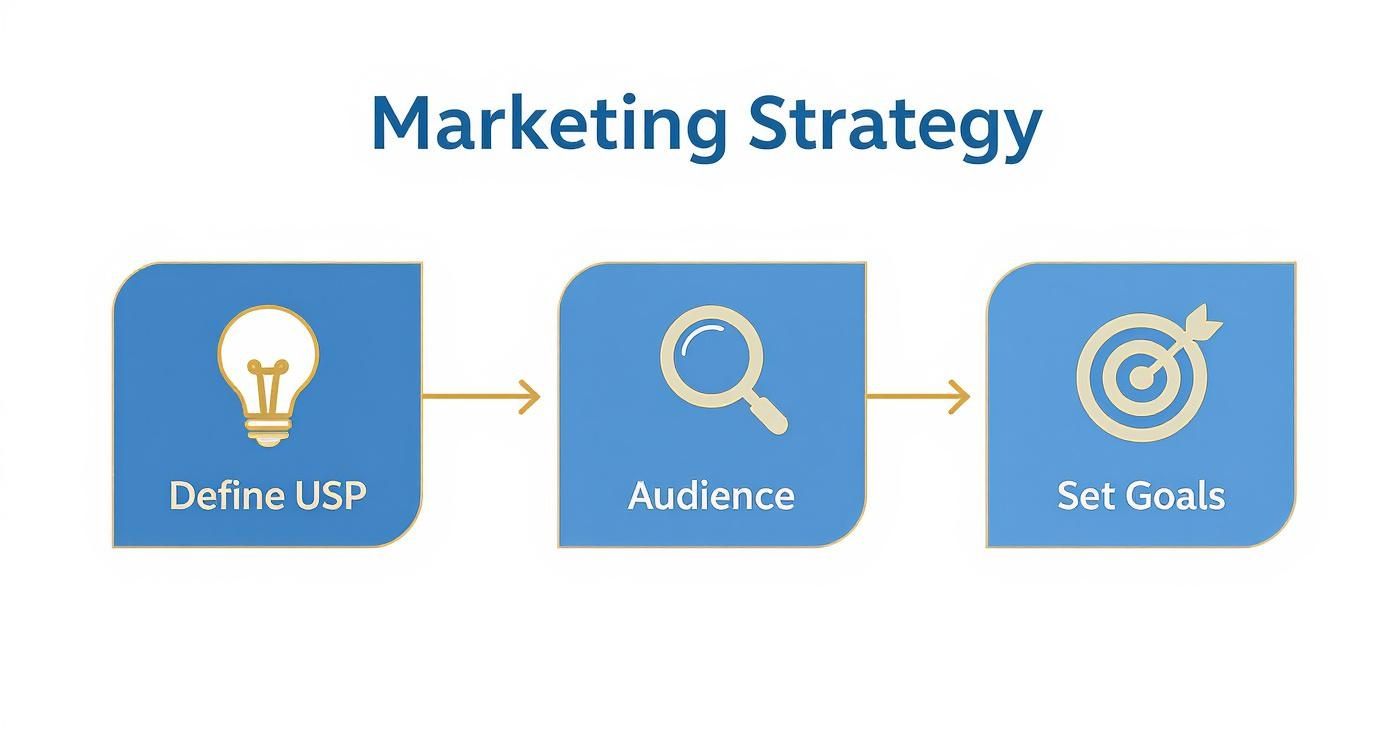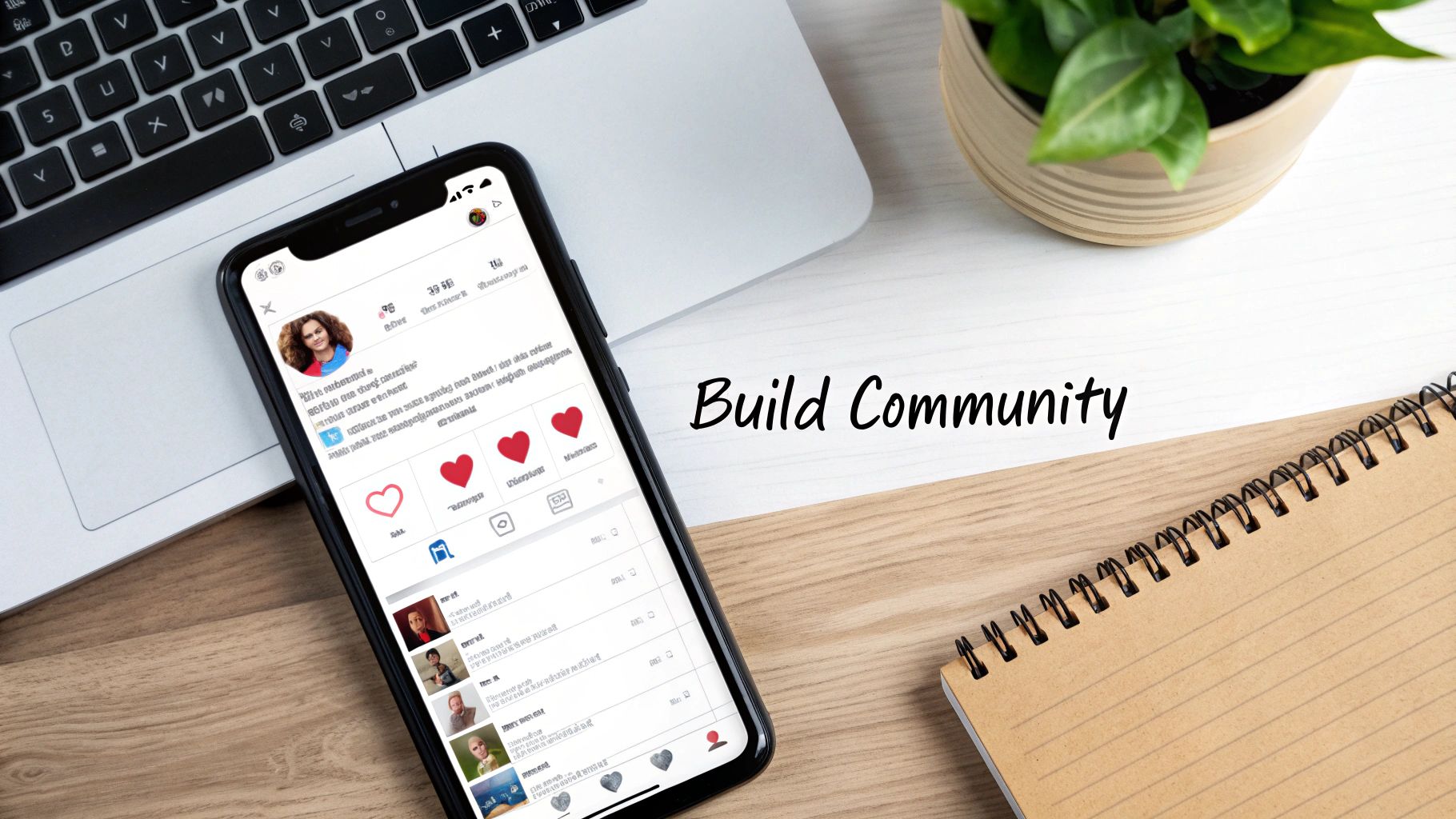
Successfully marketing your business isn't just about shouting from the rooftops; it’s about having a smart plan. It all starts with figuring out what makes you special, who you're talking to, and what you actually want to achieve.
Building Your Foundational Marketing Strategy to Market Your Business.
Before you drop a single pound on ads or even think about your first social media post, you need a plan. Trust me, jumping into marketing without a clear strategy is like trying to build a house without a blueprint—it gets expensive, messy, and the whole thing is likely to fall apart. A solid foundation makes sure every decision you make is deliberate and pushes your business forward.
This initial planning phase doesn't have to be some overly complicated, headache-inducing task. It really just boils down to answering a few key questions about your business and where it fits in the market.
Define Your Unique Selling Proposition
So, what makes your business different from the one down the street? Your Unique Selling Proposition (USP) is the core reason a customer should pick you over a competitor. It’s not just about having a great product; it’s about what makes your offering genuinely special.
Maybe you provide ridiculously good customer service, use only locally sourced materials, or have a faster delivery time. A local bakery’s USP, for instance, might be that they use only organic, locally milled flour—a huge draw for health-conscious people in the community. Nailing this down helps shape all your messaging from here on out. You can check out some powerful and memorable brand strategy examples to see how the big players do it.
Identify Your Ideal Customer
Here's a hard truth: you can't market to everyone. Trying to be everything to everybody just waters down your message and burns through your budget. The smarter move is to create a detailed profile of your ideal customer, what we often call a buyer persona. Get specific and think about their daily lives, their problems, and what they care about.
Who are they? Think about their age, where they live, what they do for a living, and their hobbies.
What keeps them up at night? Pinpoint the exact problems your product or service solves for them.
Where do they hang out? Figure out which social media platforms they scroll through or what local events they love to attend.
When you truly understand this person, you can tailor your marketing to speak directly to them in a way that feels authentic and compelling.
This infographic breaks down the simple, three-step process for getting your core marketing plan off the ground.

As you can see, a killer strategy always starts with defining your USP, followed by homing in on your audience, and then setting goals you can actually hit.
Set SMART Goals
Good marketing needs clear, achievable targets. The SMART framework is a simple but incredibly effective tool for setting goals that give your strategy real direction and make it easy to see if you're winning.
SMART stands for Specific, Measurable, Achievable, Relevant, and Time-bound. So, instead of a vague goal like "get more sales," a SMART goal would be: "Increase online sales by 15% in the next quarter by running targeted social media ads and an email promotion."
That kind of clarity turns a wish into an actual plan. It lets you track your progress and figure out what’s working and what’s not. While digital is key, don't forget about your physical presence. High-quality signage is a core part of your brand identity. It's worth exploring different types of commercial signs to elevate your brand to make sure you look the part offline, too.
To give you some context, at the start of 2025, the UK was home to around 5.7 million private sector businesses. SMEs accounted for a massive 99.9% of that total, which shows just how fierce the competition is. With London alone adding 59,000 new businesses, having a solid marketing strategy isn't just nice to have—it's essential for survival.
Ready to put this knowledge into action? The team at Baslon Digital can help you build a stunning website that acts as the cornerstone for all your marketing. Get in touch today for a free chat and let's start building your brand's future together.
Mastering Your Digital Marketing Channels
Think of your online presence as your business's 24/7 storefront. It needs to work just as hard as you do, pulling in customers even when you're asleep. Mastering a few key digital channels isn't about being everywhere at once; it's about being effective where it actually counts.
The goal is simple: create a digital footprint that attracts people. You get there by making your business dead easy to find online, creating content that solves real problems, and using ads to get in front of the right people at just the right moment.

Dominate Local Search With SEO
For most small businesses, showing up in local searches is non-negotiable. Search Engine Optimisation (SEO) is the magic—okay, the process—of making your website irresistible to search engines like Google. Get it right, and they'll show you to people actively looking for what you sell. It's the most powerful way to drive consistent, free traffic for the long haul.
A brilliant place to start? Your Google Business Profile. This free tool is what gets you on Google Maps and in that coveted local "map pack" in search results. Fill out every single detail—hours, address, services—and gently nudge your happy customers to leave reviews. It makes a huge difference.
Next, get inside your customers' heads. A plumber in Peckham isn't targeting "plumbing services." No, they're going after "emergency plumber Peckham" or "boiler repair SE15." Sprinkle these hyper-local phrases naturally across your website's pages and blog posts. It’s like sending a flare up to Google saying, "Hey! I'm right here!"
Create Content That Builds Trust
Content marketing is your chance to stop selling and start helping. It's about proving you're the expert. Businesses that blog consistently generate more leads because they're offering value before asking for the sale.
Instead of a boring page listing your services, you answer the questions your customers are already Googling.
Imagine you're a graphic designer in London. A blog post titled "5 Common Design Mistakes Small Businesses in London Make" is infinitely more useful than a page that just says "logo design services." It shows you know your stuff and instantly builds a little bit of trust.
Blogging gives you a way to attract new visitors without paying for every single click. Every post you publish is another lottery ticket for showing up in search results. And unlike ads, that visibility doesn't just switch off when your budget runs out.
Publishing genuinely helpful content has a snowball effect. One fantastic article can keep bringing in visitors and leads for years. If you need more inspiration, check out these 10 proven methods for promoting a website in 2025 to make sure your great content actually gets seen.
Use Paid Ads for Targeted Reach
SEO is the slow-cooker of marketing, but sometimes you need the microwave. Paid advertising delivers immediate results. Platforms like Google Ads let you jump to the front of the queue, placing your business right in front of people who are ready to buy.
The trick to not burning through your cash is precision.
Geographic Targeting: Don't advertise to the whole country. Set your ads to only show to people within, say, a 10-mile radius of Manchester city centre.
Keyword Targeting: Go for specific, long-tail keywords that scream intent. "Buy handmade leather bags UK" is a million times better than just "bags."
Ad Copy: Write punchy ad copy that highlights what makes you different. Always include a clear call to action, like "Get a Free Quote Today."
The game isn't about getting clicks; it's about getting customers. Start with a small daily budget you can afford to lose, and watch your results like a hawk. See which keywords are actually making the phone ring, then put more money on what works and kill what doesn't. It's this constant tweaking that gets you a proper return on your investment.
Leveraging Social Media for Real Growth
So many businesses treat social media like a digital notice board for company updates. That’s a huge mistake. It’s a powerful tool for building a genuine community of people who actually want to buy from you. Getting this right isn’t about being on every single platform. It's about showing up where your people are and creating content that builds relationships.

This means you have to move past the whole "post and pray" approach. A smart social media plan can turn what feels like a time-sucking chore into a reliable source of leads and sales.
Choosing Your Battlegrounds Wisely
The first classic mistake? Trying to be everywhere at once. A B2B consultancy firm in Manchester has almost nothing to gain from mastering TikTok, just like a trendy London fashion boutique would find LinkedIn a pretty tough crowd.
The secret is to go where your ideal customers already are.
For B2B Services: LinkedIn is your playground. It’s where you share industry insights, post case studies, and connect directly with decision-makers.
For Visual Brands: Instagram and Pinterest are non-negotiable. If you're an interior designer, a craft brewery, or a bespoke jeweller, your entire business is built on aesthetics. These platforms are made for that.
For Broad Consumer Reach: Facebook is still a monster, especially for reaching local communities and a massive range of demographics. Its Groups feature is brilliant for building niche fanbases.
For Reaching a Younger Audience: TikTok and Instagram Reels are king. Short-form video is everything here. Tap into a trend authentically, and you can get insane reach.
Pick one or two platforms to start. Master them. Spreading yourself too thin is a guaranteed recipe for being mediocre everywhere.
Crafting a Sustainable Content Calendar
Consistency is the secret sauce for social media, but it’s also the biggest pain point. A simple content calendar stops you from burning out and keeps your message on point. You don't need fancy software—a Google Sheet works just fine.
A content calendar isn't just a schedule; it's a strategic tool. It ensures you maintain a healthy mix of promotional, educational, and engaging content, preventing your feed from becoming a one-note sales pitch.
Plan your posts around a few key content "pillars." For example, a local coffee shop's pillars could be:
Behind the Scenes: Showcasing the coffee roasting process.
Community Spotlight: Featuring local artists or regulars.
Educational: Quick tips on brewing the perfect cup at home.
Promotional: Highlighting the 'scone of the week' offer.
This makes creating content a million times easier and makes sure your audience gets something valuable every time they see your posts.
Running Targeted Ads That Actually Work
Let's be real: organic reach can be brutal. That’s where paid advertising comes in. Social media ads let you get ridiculously specific about who sees your stuff. You can target people based on their location, age, interests—even their recent online behaviour.
The UK social media ad market is set to hit a massive £9.95 billion by 2025, with 79% of the population on social platforms. These numbers scream opportunity. It shows just how critical paid social campaigns are for UK businesses to pinpoint specific customer groups.
Platforms like Twitter, for instance, offer unique ways to build trust and have real conversations. There are some great guides on connecting with clients through Twitter that are well worth a read if you're just getting started.
Ready to turn your social media into a machine that actually generates leads? Baslon Digital builds websites that work hand-in-hand with your social strategy, helping you turn followers into paying customers. Book a discovery call with us today and let's have a chat.
Turning Your Email List into a Sales Engine
Let’s be honest, your email list is one of the most powerful marketing assets you will ever own. It’s a direct line to people who have already raised their hand and said, "Hey, I'm interested." Forget fighting for scraps of attention on social media—email is your personal, direct way to turn curious subscribers into loyal customers.

This connection is where you can build real relationships. A social post vanishes in minutes, but an email sits patiently in an inbox, waiting to be opened. When you get it right, email marketing can drive serious sales, gather priceless feedback, and create a tribe of brand advocates.
Building Your List the Right Way
Before you can send a single email, you obviously need a list. The golden rule here is permission. I can't stress this enough: never, ever buy an email list. Not only is it a one-way ticket to the spam folder, but it’s also a big no-no under GDPR regulations here in the UK.
Instead, you need to give people a genuinely good reason to sign up.
Offer a Killer Lead Magnet: This is a freebie you give in exchange for an email. Think checklists, a short and punchy guide, a cheeky discount code, or access to an exclusive webinar. Make it irresistible.
Use Clear Opt-in Forms: Don’t make people hunt for the sign-up box. Place simple, easy-to-fill-out forms on your website—in the footer, as a pop-up, or at the end of every blog post.
Pull from Social Media: Run a competition or promote your lead magnet on your social channels, driving your followers to a dedicated sign-up page.
Remember this: a smaller, engaged list of people who actually want to hear from you is worth a hundred times more than a massive list of folks who have no clue who you are.
Crafting Emails People Actually Open
Your subject line is the gatekeeper. It doesn't matter if your email contains the secrets to the universe; if the subject line is boring, it's not getting opened. Your mission is to be intriguing without being clickbait.
Think about what would make you click. A subject line like "Our New Products" is a total snooze-fest. But "A Sneak Peek Just for You" or "Your Weekend Plans Just Got Better"? Now you’ve got my attention. Keep it short, use emojis (sparingly!) to add some personality, and try personalising it with their name.
The real power of email isn't just in what you send, but who you send it to. Simple segmentation—dividing your list into smaller groups based on their interests or purchase history—can dramatically improve your results.
For example, sending a special offer on dog toys only to customers who've bought dog-related stuff before makes the email feel personal and relevant, not like a generic blast to the masses.
Types of Campaigns That Drive Action
Not every email should be a hard sell. Please, don't just shout "BUY NOW!" all the time. A healthy email strategy mixes different types of content to keep your audience hooked. B2B email marketing in the UK, in particular, has really shifted towards a focus on data quality and AI-powered personalisation. Smart UK businesses now prioritise clean, compliant, and segmented lists to target specific decision-makers. This data-first approach, tailoring campaigns by job role, sector, or past interactions, has been a game-changer for nurturing leads. You can find more insights on UK B2B email marketing trends on dma.org.uk.
Here are a few campaign types to get you started:
The Welcome Series: Don't just send one welcome email and call it a day. Create a short series of 3-4 emails that introduces your brand, sets expectations, and offers immediate value.
The Promotional Campaign: This is your classic sales email. Think clear visuals, copy that gets to the point, and a big, bold call to action that drives people to your offer or product launch.
The Nurture Sequence: For subscribers who aren't quite ready to buy, send a series of genuinely helpful, educational emails. Solve a problem for them, build trust, and slowly position your business as the go-to expert.
Comparing Key Email Marketing Platforms for SMEs
Choosing the right tool can feel a bit overwhelming, but it's crucial for getting your strategy off the ground. For small and medium-sized UK businesses, you need something that's powerful yet doesn't require a degree in computer science to operate.
Platform | Best For | Key Feature | Typical Starting Price |
|---|---|---|---|
Beginners and small businesses | Incredibly user-friendly drag-and-drop builder and great reporting. | Free plan available; paid plans start around £10/month. | |
Growing businesses on a budget | Offers advanced features like automation and landing pages at a competitive price. | Free plan available; paid plans start around £7/month. | |
Businesses focused on automation | Powerful marketing automation that rivals much more expensive platforms. | Starts from around £25/month. | |
All-in-one marketing needs | Combines email, SMS marketing, chat, and CRM in one platform. | Free plan available; paid plans start around £16/month. |
Each platform has its own personality. Mailchimp is the friendly, reliable choice for getting started, while a tool like ActiveCampaign is for when you're ready to get serious with complex automated workflows. The best advice? Sign up for a free trial and see which one feels right for you.
By building your list the right way and sending stuff people actually want to read, you can transform your email database from a list of contacts into a reliable engine for sales and customer loyalty.
Ready to build a stunning website that makes it easy to capture emails and grow your business? Baslon Digital specialises in creating custom websites that drive results. Contact us today to learn more.
Finding Customers Through Offline Connections
In a world drowning in digital noise, a real, face-to-face connection can cut through the clutter. Let's be honest, clicks and likes are great, but they don't build trust the way a proper handshake does. Think of offline marketing as your secret weapon.
It’s how you build a solid, tangible presence in your local community, reaching people who might scroll right past your social media ad without a second thought. This isn't about ditching your digital strategy; it's about giving it a human side. When you show up in the real world, your brand becomes more memorable and relatable. It’s all about creating genuine connections that blossom into loyal customers and fantastic word-of-mouth referrals.
Master the Art of Local Networking
For a lot of us, the word "networking" conjures up images of awkward chats and forced smiles. It really doesn't have to be like that. Good networking isn't about a hard sell; it's about building genuine relationships in your local business scene. The trick is to flip your mindset from "what can I get?" to "what can I give?".
Next time you're at a local business event or a chamber of commerce meeting, make it your mission to just listen. Ask people about their business, what they're struggling with, what they're celebrating. When it’s your turn to talk, have a sharp 'elevator pitch' ready. This isn't a sales script; it's a 30-second summary of who you help and what problem you solve for them.
For example, instead of a flat "I'm a web designer," try something with a bit more punch: "I help local retail shops in London create stunning websites that actually turn visitors into paying customers." See the difference? It’s specific, focuses on the benefit, and sticks in their mind.
The real magic of networking happens after the event. A quick, personalised follow-up email or a LinkedIn connection mentioning something you discussed can turn a brief chat into a proper professional relationship. It proves you were actually listening.
Use Local Media to Your Advantage
You don't need a massive PR budget to get some local press. Local journalists, bloggers, and radio presenters are always on the hunt for interesting stories about businesses in their patch. A simple, well-written press release can work wonders.
Think about what makes your business newsworthy.
Are you hosting a charity event?
Have you just hired a bunch of new local staff?
Did you recently win a local business award?
Are you launching a unique new product or service?
Keep your press release short, snappy, and free of jargon. Give it a compelling headline, put the most important info right at the top, and include a quote from yourself. Most importantly, make the journalist's life easy by including your contact details and a link to your website. This is how you start building a reputation as a mover and shaker in your local economy.
Get Creative with Sponsorships and Print
Digital ads are powerful, sure, but don't write off traditional media just yet, especially for hitting specific local groups. Sponsoring a local youth sports team or a community festival can get your brand name in front of hundreds of local families and build some incredible goodwill. Your logo on a team's shirt is a walking billboard that says you care about the community.
In the same way, a well-designed flyer or direct mail piece can still be massively effective. Imagine a local estate agent sending a beautifully designed mailer to a specific neighbourhood, offering a free home valuation. It’s a targeted approach that can reach homeowners who aren't actively searching online but might be tempted by a professional, tangible offer landing on their doormat.
With all these offline tactics, the goal is to become a familiar, trusted name in your community. A strong local reputation is an invaluable asset that backs up and strengthens every single one of your digital marketing efforts.
Ready to create a professional online hub that perfectly captures your brand's offline reputation? Baslon Digital builds beautiful, high-performing websites that make a lasting impression. Get in touch with us today to discuss your project.
Tracking What Works and Optimising for Growth
Right, let's talk about the bit everyone forgets. Marketing without measuring is just setting fire to your budget. After all that effort you’ve put into strategy, content, and chatting with customers, this is where the magic really happens. This is how you turn good marketing into great marketing.
By tracking what’s actually working, you can make smarter decisions, stretch every pound further, and drive real, sustainable growth. It's about moving from guesswork to certainty. You'll finally know which social posts are driving sales, which emails are getting clicks, and which blog articles are bringing in the right kind of visitors. This data is pure gold.
Identifying Your Key Performance Indicators
Before you can measure anything, you need to know what to measure. These are your Key Performance Indicators (KPIs) – the specific numbers that tell you if you're hitting your goals. Don't get bogged down by the ocean of data out there; just focus on the metrics that genuinely matter for each channel.
Here’s a simple starting point:
Website Traffic: Jump into a tool like Google Analytics and keep an eye on unique visitors, pages per session, and the bounce rate. These tell you how many people are showing up and whether they find your site interesting enough to stick around.
Social Media: Look past the vanity metrics like follower counts. The real story is in the engagement rate (likes, comments, shares) and the click-through rate (CTR) on your links. Is your content actually making people do something?
Email Marketing: Two numbers rule them all here: the open rate and the click-through rate. They'll tell you if your subject lines are grabbing attention and if your content is compelling enough to earn a click.
Getting your head around website analytics is fundamental. If you're new to it, we've got a simple guide that explains what website analytics is and how to get started.
Using A/B Testing to Improve Results
Once you know your numbers, you can start making them better. A/B testing (or split testing) is a dead simple way to figure out what works best. It sounds technical, but it’s not. You just test two versions of something to see which one gets a better reaction.
A/B testing takes the guesswork out of marketing. Instead of wondering which headline is better, you let your audience's behaviour give you the definitive answer. It’s one of the most powerful ways to make tiny changes that lead to huge improvements.
For instance, you could send the same email but with two different subject lines.
Version A: "Save 20% On All Orders This Weekend"
Version B: "Your Weekend Treat: A Special 20% Off"
By tracking the open rates, you’ll quickly see which style of language gets more people to bite. You can do this with almost anything: the colour of a "Buy Now" button, the image in a social media ad, or the headline on a blog post.
Creating Simple Dashboards for a Clear View
You don’t need fancy, expensive software to see how you're doing. A simple spreadsheet or a free tool like Google Data Studio can pull all your most important KPIs into one place. Think of it as your marketing command centre.
Check your dashboard weekly. This regular check-in helps you spot trends, see what’s flopping, and pour more fuel on the strategies that are delivering the goods. If your Instagram posts are driving a ton of traffic, you know where to focus your energy. On the flip side, if your Facebook ads aren't converting, you can hit pause and put that budget somewhere it will actually work.
This continuous loop of measuring, testing, and tweaking is the engine of effective marketing. It ensures you’re not just staying busy, but are actively building a smarter, more efficient marketing machine that gets real results.
Ready to build a stunning website that serves as the perfect foundation for all your marketing efforts? The team at Baslon Digital specialises in creating beautiful, high-performing websites that are built to convert. Visit us at https://www.baslondigital.com to learn more and book a free consultation.


